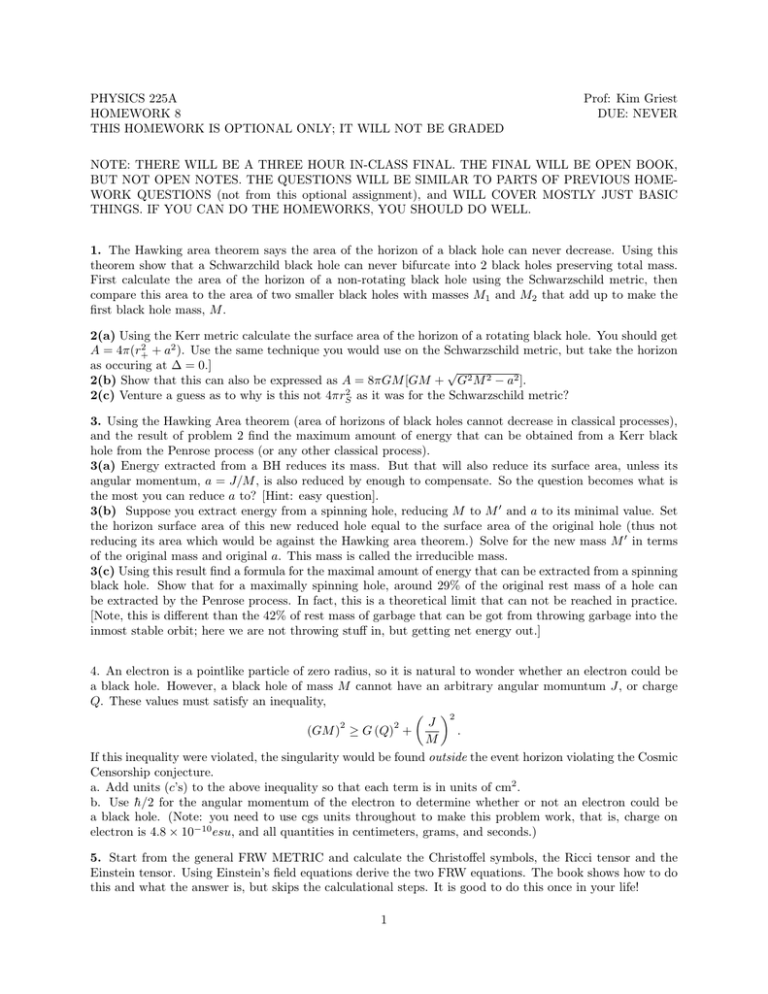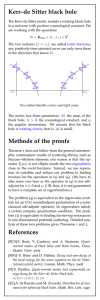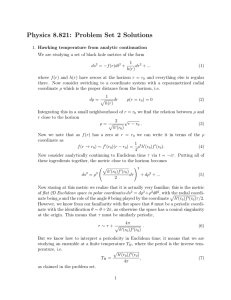PHYSICS 225A Prof: Kim Griest HOMEWORK 8 DUE: NEVER
advertisement

PHYSICS 225A HOMEWORK 8 THIS HOMEWORK IS OPTIONAL ONLY; IT WILL NOT BE GRADED Prof: Kim Griest DUE: NEVER NOTE: THERE WILL BE A THREE HOUR IN-CLASS FINAL. THE FINAL WILL BE OPEN BOOK, BUT NOT OPEN NOTES. THE QUESTIONS WILL BE SIMILAR TO PARTS OF PREVIOUS HOMEWORK QUESTIONS (not from this optional assignment), and WILL COVER MOSTLY JUST BASIC THINGS. IF YOU CAN DO THE HOMEWORKS, YOU SHOULD DO WELL. 1. The Hawking area theorem says the area of the horizon of a black hole can never decrease. Using this theorem show that a Schwarzchild black hole can never bifurcate into 2 black holes preserving total mass. First calculate the area of the horizon of a non-rotating black hole using the Schwarzschild metric, then compare this area to the area of two smaller black holes with masses M1 and M2 that add up to make the first black hole mass, M . 2(a) Using the Kerr metric calculate the surface area of the horizon of a rotating black hole. You should get 2 A = 4π(r+ + a2 ). Use the same technique you would use on the Schwarzschild metric, but take the horizon as occuring at ∆ = 0.] √ 2(b) Show that this can also be expressed as A = 8πGM [GM + G2 M 2 − a2 ]. 2(c) Venture a guess as to why is this not 4πrS2 as it was for the Schwarzschild metric? 3. Using the Hawking Area theorem (area of horizons of black holes cannot decrease in classical processes), and the result of problem 2 find the maximum amount of energy that can be obtained from a Kerr black hole from the Penrose process (or any other classical process). 3(a) Energy extracted from a BH reduces its mass. But that will also reduce its surface area, unless its angular momentum, a = J/M , is also reduced by enough to compensate. So the question becomes what is the most you can reduce a to? [Hint: easy question]. 3(b) Suppose you extract energy from a spinning hole, reducing M to M 0 and a to its minimal value. Set the horizon surface area of this new reduced hole equal to the surface area of the original hole (thus not reducing its area which would be against the Hawking area theorem.) Solve for the new mass M 0 in terms of the original mass and original a. This mass is called the irreducible mass. 3(c) Using this result find a formula for the maximal amount of energy that can be extracted from a spinning black hole. Show that for a maximally spinning hole, around 29% of the original rest mass of a hole can be extracted by the Penrose process. In fact, this is a theoretical limit that can not be reached in practice. [Note, this is different than the 42% of rest mass of garbage that can be got from throwing garbage into the inmost stable orbit; here we are not throwing stuff in, but getting net energy out.] 4. An electron is a pointlike particle of zero radius, so it is natural to wonder whether an electron could be a black hole. However, a black hole of mass M cannot have an arbitrary angular momuntum J, or charge Q. These values must satisfy an inequality, 2 J 2 2 (GM ) ≥ G (Q) + . M If this inequality were violated, the singularity would be found outside the event horizon violating the Cosmic Censorship conjecture. a. Add units (c’s) to the above inequality so that each term is in units of cm2 . b. Use h̄/2 for the angular momentum of the electron to determine whether or not an electron could be a black hole. (Note: you need to use cgs units throughout to make this problem work, that is, charge on electron is 4.8 × 10−10 esu, and all quantities in centimeters, grams, and seconds.) 5. Start from the general FRW METRIC and calculate the Christoffel symbols, the Ricci tensor and the Einstein tensor. Using Einstein’s field equations derive the two FRW equations. The book shows how to do this and what the answer is, but skips the calculational steps. It is good to do this once in your life! 1





